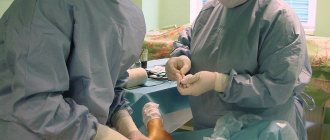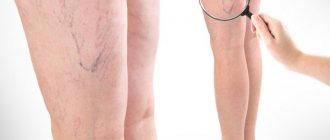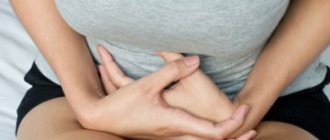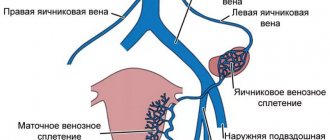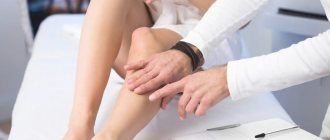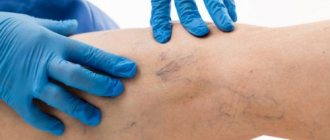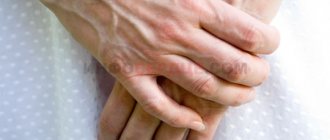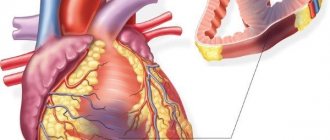Varicose veins are a disease that affects blood vessels, leading to their deformation. Due to the expansion of the veins, their lengthening, thinning of the vascular wall and worsening depletion of the valves, the systemic circulation is disrupted, and blood stagnation in the veins also occurs.
According to statistics, about 19% of the world's population suffers from varicose veins, while it is also known that women are twice as likely to develop this pathological process. This article will discuss the reasons for the development of varicose veins in women, as well as how to combat this disease.
Causes of varicose veins in women
Varicose veins do not appear by chance. The first symptoms that make you think about weakening of blood vessels are:
- the appearance of venous networks;
- heaviness in the legs after walking;
- night awakenings;
- leg cramps;
- traces of swelling on the legs;
What causes varicose veins? There are a number of reasons for this:
- Sedentary lifestyle.
- Choosing uncomfortable shoes.
- Chronic hypertension.
- Diabetes.
- Smoking and alcoholism.
- Genetic inheritance.
- Overweight.
- Taking certain medications.
- Tanning abuse.
- Stress, neuroses.
- Elderly age.
Of course, there are more reasons for the appearance of varicose veins, but the ones listed are the key ones and lead to vein disease in 60% of the world’s population.
Interesting fact! Most people suffering from varicose veins are women.
Their number among the sick is 80%.
Why veins appear - reasons
Often problems with veins in the legs are hereditary. In this case, it is necessary to begin taking preventive measures as early as possible. But more often the appearance of this disease is provoked by concomitant diseases, hormonal changes, and unhealthy habits.
An incorrect diet and excessive consumption of unhealthy, fatty, high-calorie foods cause an increase in the level of bad cholesterol. And the love for fast carbohydrates provokes surges in blood glucose levels.
Other causes of varicose veins in women include:
- hormonal changes associated with teenage and menopausal changes, pregnancy;
- work that requires prolonged sitting or standing, constant stress on the legs;
- lack of physical activity, passive lifestyle, excess weight.
Prolonged immobility in any position provokes stagnation of blood circulation. To avoid this problem, you need to periodically warm up and change your body position.
Important! Beautiful, but tight and uncomfortable underwear, narrow shoes with high heels can also lead to the formation of varicose veins.
How to treat varicose veins with folk remedies at home
For opponents of conservative treatment with medications, there is a wonderful alternative. Products of plant and animal origin will help cope with varicose veins no worse than tablets.
Our nature is rich in plants that can save us from many diseases. In previous centuries, herbal medicine was a panacea for all diseases. Medicinal herbs could be found in every hut, but not many knew how to correctly calculate the dosage and select the appropriate herbs for the disease. Let's consider several recipes for internal and external use that help in the treatment of varicose veins:
- Horse chestnut tincture. To prepare the infusion, take 3 tablespoons of flowers and 6 fruits of the plant. Grind all this in a coffee grinder and pour half a liter of vodka. Next, you should infuse the product for two weeks in a dark place. Use this product to apply lotions to your feet.
- Lime tea. You need to take two tablespoons of dried linden flowers and pour 200 ml of boiling water over them. This drink should be given 20 minutes to brew, and then taken as regular tea.
- Sage tea. This recipe requires 2 tablespoons of regular black tea and two teaspoons of dry sage herb. Brew this mixture with boiling water in a regular teapot and let it brew for 15 minutes. This drink should be taken daily, adding a slice of lemon to the cup.
- Garlic compress. Mix chopped garlic with butter in a 2:1 ratio. Apply this mixture to the diseased veins twice a day, fixing the products to the leg with parchment and a scarf, creating a heat compress. This method cannot be used if there are open wounds on the skin.
- Lotions made from wormwood and milk. For this recipe you will need sour milk and wormwood herb. Mix the ingredients in such proportions to make a paste. Soak gauze pads in the resulting mixture and apply to the diseased veins.
- Apple vinegar. To effectively get rid of spider veins, it is enough to apply gauze pads soaked in apple cider vinegar and water in a 1:1 ratio twice a day.
The main contraindications to such folk treatment are skin diseases and allergic reactions. When using infusions and decoctions for internal use, pregnant and lactating women should be careful. Before using these recipes, consultation with a specialist is required.
You can also purchase ready-made teas or mixtures at the pharmacy that help strengthen blood vessels, improve blood circulation and reduce swelling. They will contain the necessary herbs, the dosage of which is calculated precisely.
Surgery
In severe and advanced cases, when medications no longer help, surgical treatments are used.
Currently, the following surgical treatment methods are widely used:
- Radiofrequency ablation of veins. The method involves inserting a special crater into the dilated vein, which is subsequently heated. This leads to heating and gluing of the diseased vein. Then the crater is removed, the procedure is carried out under ultrasound guidance.
- Endovenous laser coagulation. The essence of the method is that a laser light guide is inserted into the dilated vein, which cauterizes the vein.
- Phlebosclerotherapy. A drug with a sclerosing effect is injected into the affected vein. He glues the vein together, the procedure is carried out under ultrasound control.
These methods are relatively new and have many advantages. RAV and ELK are performed under local anesthesia, have a short recovery period and are suitable for women who do not want the procedure to take a long time.
Another advantage is the absence of a postoperative scar. But the methods also have unpleasant consequences: the possibility of relapse, high cost.
Phlebosclerotherapy is performed without anesthesia. The procedure is absolutely painless and does not require hospitalization. After the operation there is no scar, this is important for women who care about the beauty of their legs. The disadvantages are: the possibility of inflammation and relapse.
Pigmentation may also occur at the puncture site.
The type of surgical intervention depends not only on the wishes of the patient, but also on the indications.
The traditional method (phlebectomy) aims to remove dilated veins. To do this, an incision is made in the groin area or under the knee. The affected vein is pulled through the hole and removed using a special instrument.
The advantages of this type of operation are: high efficiency and its implementation at any stage of the disease.
There are also disadvantages:
- general or spinal anesthesia;
- long rehabilitation period (about a week);
- presence of scars after surgery;
- bleeding and infection are possible;
- injury to nearby tissues;
- occurrence of relapse.
There is also another surgical method for treating varicose veins on the legs. This is a miniphlebectomy. It is used when the disease is just beginning. The procedure is performed as follows: the affected vein is pulled out through a small puncture with a special hook and then closed.
Nutrition for varicose veins
Proper nutrition means a complete abstinence from alcohol, fatty, fried, and highly salted foods. Meals should be timely, approximately 4-5 times a day in small portions. Let's consider permitted and prohibited products for varicose veins, for its effective elimination and prevention.
Authorized products:
- vegetables;
- fruits (except grapes, melon);
- cereals;
- sea buckthorn, olive, linseed oil;
- green and black tea;
- beef, horse meat, chicken, rabbit;
- lean fish;
- cheese;
- butter (10g per day);
- rye bread, homemade oatmeal cookies;
- freshly squeezed juices without sugar;
- mushrooms;
- beans, soybeans;
- seaweed;
- dried fruits;
- seafood;
- nuts.
Among fruits, pay attention to citrus fruits, which prevent oxidative processes in the body and act as powerful antioxidants. They also tend to strengthen the walls of blood vessels, reducing their fragility.
Vegetables help saturate the body with B vitamins, potassium, magnesium, which is very important for frequent pain and cramps. Pay attention to green vegetables such as bell peppers, cucumbers, spinach, greens, Jerusalem artichoke, broccoli, celery.
To prevent any diseases, it is recommended to focus on protein foods, which is why daily intake of legumes and meat is recommended. It should be remembered that the meat should be of low-fat varieties. It's better to steam it. Fried meat is a direct path to high cholesterol.
Dried fruits are essential for the body because they contain large amounts of potassium and magnesium. These microelements are needed for the normal functioning of muscles and the nervous system as a whole.
Olive and flax oils are direct sources of omega fatty acids, thanks to which you can effectively cleanse blood vessels, which will be a good prevention of atherosclerosis.
Prohibited products:
- alcohol;
- coffee;
- chocolate and candies;
- salted herring;
- salo;
- flour products;
- fried foods;
- carbonated drinks;
- mayonnaise;
- chips, fast food.
Salty foods and alcohol cause excessive swelling in the lower extremities, which is extremely dangerous for blood vessels.
Coffee thickens the blood, which impairs circulation and causes heaviness in the legs.
Advice! Do not drink water at night, as fluid retention in the body will reward you with morning swelling, heaviness in the legs and high blood pressure.
Lard, mayonnaise, fast food and fried foods lead to increased cholesterol levels and, accordingly, to atherosclerosis in the future.
Drug therapy
The basis of treatment for varicose veins in any patient is medications. Products in the form of tablets have the greatest effect, and ointments, gels and creams for external use will complement the result and reduce the severity of symptoms.
Each medicine has contraindications and side effects, and therefore must be prescribed by the attending physician - a vascular surgeon or phlebologist.
Oral medications for varicose veins can be divided into three types: the first restore healthy blood circulation, the second prevent the development of complications, and the third relieve the symptoms of pathology. The treatment regimen may consist of a combination of the following groups of drugs:
- anticoagulants and antiplatelet agents that thin the blood;
- phlebotonics, restoring vein tone;
- angioprotectors that protect blood vessels from harmful effects and reduce the permeability of their walls;
- antioxidants that resist oxidative reactions;
- non-steroidal anti-inflammatory drugs, antispasmodics and corticosteroid drugs that relieve inflammation, swelling and pain;
- vitamin and mineral complexes and immunomodulators to restore the body’s own ability to resist diseases and negative influences from the outside.
When taking any medication, the dosage and frequency prescribed by your doctor must be followed. Usually, several drugs from different groups are prescribed in short courses to achieve better results. The most popular tablets for varicose veins are presented in the table:
| Name | Group | Mode of application | Contraindications | Price |
| Venarus | Angioprotector, phlebotonic | 1-2 tablets per day, divided into two doses with meals - at lunchtime and in the evening. | Allergies, lactation period. | From 550 rub. |
| Detralex | Angioprotector, phlebotonic | 2 tablets per day in one or two doses with meals. | Allergy. | From 750 rub. |
| Trental | Angioprotector | 1 tablet three times a day, gradually increasing the dosage as prescribed by the doctor. | Bleeding and hemorrhage, acute myocardial infarction, age less than 18 years, pregnancy and lactation, allergies. | From 500 rub. |
| Troxevasin | Angioprotector | 1 capsule three times a day with meals, gradually reduce the dosage as prescribed by your doctor. | Stomach or duodenal ulcer, acute gastritis, early pregnancy, allergies. | From 350 rub. |
| Venoruton | Angioprotector, phlebotonic | 1 capsule three times a day with meals, gradually reduce the dosage as prescribed by your doctor | Allergies, early pregnancy. | From 800 rub. |
| Diclofenac | Nonsteroidal anti-inflammatory drug | 1 tablet 2-3 times a day during or after meals. | Stomach or duodenal ulcer, internal bleeding. “aspirin” asthma, hemophilia, pregnancy and lactation, childhood, allergies. | From 15 rub. |
Anticoagulants are prescribed only if there is an immediate risk of blood clots, and the drug is selected by the doctor individually, based on the patient’s characteristics. Antioxidants also have a place only if complications are likely. Vitamin and mineral complexes are selected in each specific case according to indications.
Gymnastics for varicose veins
A few simple exercises at home will help keep your blood vessels healthy and avoid varicose veins in the future:
- Bike. For this exercise, you need to lie on your back on a flat surface. The legs must be bent at the knees and raised so that a 90-degree angle is formed between the stomach and hips. In this position, you need to imitate riding a bicycle for two minutes, then take a break and repeat the task.
- Birch. A simple children's exercise that can save blood vessels from varicose veins. If balance is not your thing, then you can do the exercise against the wall. You need to lie on your back. Leaning your elbows on the floor, raise your legs and pelvis up as much as possible. You need to stay in this position for one minute, then rest and return to the task.
- Swing your legs. Starting position – stand straight, hands on your belt. On the first count, raise your leg to the side 70 degrees, hold in this position for 2 seconds, then smoothly return to the starting position. Repeat the task with the second leg.
- Ladder. The exercise can be done on the floor or on a step. Stand on the edge of the step with your toes, place your hands on your belt. It is necessary to smoothly rise up and down without lifting your toes from the floor. Do 20 lifts, then rest. Repeat the exercise.
Signs
- External visualization of vessels on the thighs and legs. First in the form of a capillary network, then a pronounced pattern. As the disease progresses, convex, tortuous veins appear;
- Pain in the legs during a long walk;
- A bluish tint to the skin over bulging veins;
- Knees and feet swell at the end of the day;
- Cramps leg muscles in sleep.
The severity of symptoms of varicose veins of the legs depends on the stage of the disease:
- Stage 1, initial – signs of the disease are mild, evening swelling of the legs and aching pain are observed;
- Stage 2 – capillary patterns, spider veins, and small vein nodules are visible on the surface of the skin. Heaviness in the legs is accompanied by night cramps and burning in the blood vessels;
- Stage 3 - swelling becomes pronounced, the vascular pattern becomes bright, pain is intrusive, preventing a woman from living a full life;
- Stage 4 is characterized by changes in the color and condition of the skin of the legs. It cracks, peels, and darkens in the ankle area. Vein nodules form as if in clusters and become sensitive to damage. The formation of ulcers on the legs is possible - this is already an advanced disease, which develops into more complex forms of vascular pathology.
At approximately the third stage of varicose veins of the legs, such a dangerous phenomenon as reflux occurs - this is the reverse flow of blood from large veins into small vessels. Such confusion in blood circulation further weakens the vascular system and accelerates the development of varicose veins.
When to see a doctor
Patients often consult a doctor in the later stages, when varicose veins are difficult to treat. In order not to miss precious time, you should consult a doctor at an early stage, the symptoms of which are:
- feeling of tiredness in the legs after walking;
- swelling of the lower extremities;
- night cramps;
- a feeling of pins and needles or numbness in the legs;
- painful sensations.
If you listen to your body in time, you can avoid the unpleasant consequences of varicose veins. If at least one symptom is detected, it is recommended to contact a phlebologist or vascular surgeon as soon as possible for diagnosis.
How to recognize the disease - symptoms
Many women skip the initial stage of the disease, attributing the discomfort to uncomfortable shoes, fatigue, or hot weather. But with varicose veins, the main thing is not to start the disease and start timely treatment.
Signs of varicose veins in women:
- The feet and legs often begin to swell; swelling can affect each leg separately;
- In the evening, an unbearable burning sensation occurs in the calves, the muscles seem to be bursting from the inside;
- a fine mesh appears on the legs, it is more difficult to notice on dark skin;
- pigmentation, spider veins affecting the lower legs;
- cramps begin to bother you during sleep;
- the veins become very noticeable, and when pressed, severe pain occurs.
The disease is also accompanied by prolonged healing of bruises and abrasions. The skin on the calves acquires a denser structure, shines, and hair loss may occur in a certain area.
Physical activity and staying on your feet for a long time increases the manifestation of unpleasant sensations. You should consult a doctor who treats varicose veins if two or more signs appear.
Important! Varicose veins are not only an aesthetic problem, but also a very dangerous disease. Poor vein patency leads to the formation of blood clots. And this is always a high risk of sudden death.
Treatment of varicose veins in pregnant women
Pregnancy is a special period when almost all medications are contraindicated, which means other treatment methods are used.
In late pregnancy, high stress occurs on the lower limbs, causing swelling and heaviness. In such cases, a pregnant woman should use recipes for external use, including lotions made from wormwood, horse chestnut and apple cider vinegar. Foot baths with sea salt, which can relax muscles and blood vessels, will be very helpful.
An important point for the expectant mother is nutrition. A properly balanced menu combined with external methods of getting rid of varicose veins will help cope with the symptoms of the disease. In addition, to keep a pregnant woman’s veins in good shape, it is necessary to use compression garments. The best option would be to use tights, and to protect the pelvic vessels, it is recommended to wear a prenatal bandage. Do not neglect going to classes for pregnant women, where exercise therapy is fully practiced, aimed at strengthening muscles, blood vessels and joints.
What to do with varicose veins of the legs?
Conservative treatment of varicose veins on any part of the body is possible only with damage of 1-2 degrees. In some cases, it is possible to cope with the disease without the use of surgical methods with grade 3 varicose veins, but the likelihood of this is very low.
Stages of varicose veins of the lower extremities
| Disease stage | What is it characterized by? | Degree of disability |
| First | Subcutaneous lesion, which in most cases is simply a cosmetic defect and does not affect the development of pathological processes. No blood reflux | Functionality remains fully intact |
| Second | Segmental varicose veins, in which there is a violation of the outflow in one or more venous ducts with a diameter exceeding 3 mm. | The ability to work is slightly reduced, but with the use of maintenance therapy the patient can perform the usual amount of work |
| Third | Extensive varicose lesions with impaired venous outflow in perforating and superficial veins | The patient is able to perform professional duties for 6-8 hours subject to constant supportive treatment |
| Fourth | Dilatation of deep veins with severe blood reflux | Work ability is impaired even with the use of symptomatic and therapeutic therapy |
To treat varicose veins at any stage, a woman must adhere to a special therapeutic diet with a high content of vegetables and herbs. Cold-pressed vegetable oils are useful for varicose veins, as they contain a lot of tocopherol, which strengthens the walls of blood vessels and prevents the formation of blood clots. It is better to give preference to almond, olive, pumpkin and grape oils. Among the vegetables, cabbage, eggplant, zucchini, bell peppers and carrots are especially useful.
Types of varicose veins
In your daily diet for varicose veins, you must include:
- fish and seafood;
- dried, frozen and fresh berries and fruits;
- legumes (peas, lentils, beans);
- nuts;
- lean meat (consumption of pork and other types of meat with a high fat content should be limited to once a week);
- dairy products with a fat content of no more than 5% (for cottage cheese, fat content is allowed in the proportion of 9 g per 100 g of product).
At any stage of varicose veins, drinks containing caffeine or ethyl alcohol, butter, margarine, smoked meats (especially industrially processed ones), marinades and fatty sauces are prohibited.
Complications of varicose veins
Important! Diet for varicose veins is the main part of complex treatment, but it must be combined with drug therapy prescribed by a doctor and traditional methods (in the absence of indications).
Prevention of varicose veins
To prevent vein diseases, the following tips are given:
- Switch to proper nutrition.
- Exercise.
- Use herbal infusions.
- Wear compression stockings.
- Quit smoking and alcohol.
- Monitor the condition of the body when taking hormonal drugs.
- Wear high-quality orthopedic shoes.
- Take a contrast shower.
- Avoid the “leg-to-leg” pose.
Such simple tips will help avoid the manifestations of varicose veins and strengthen the entire cardiovascular system.
Useful fact! If you are going on a trip, be sure to equip yourself with compression garments, because during a long trip the blood vessels weaken and can cause swelling, as well as other unpleasant symptoms.
Consequences of the disease
Ignoring the disease can lead to serious complications and many associated diseases. What are the dangers of varicose veins on the legs of women? It is interesting to know that varicose veins in men are different from female vein disease.
- Venous insufficiency begins in the affected areas. And it can all end in gangrene and removal of dead tissue.
- Varicose veins often develop into thrombophlebitis and thrombosis, and the formation of trophic ulcers begins.
Physiology of veins
Blood in the veins in the systemic circulation flows towards the heart, unlike the pulmonary circulation. Since, reading this article, we are interested in the veins in the legs, many may ask an interesting question: how does blood move from bottom to top? Or what makes it move against gravity? There are several reasons for this phenomenon:
- The work of venous-muscular pumps. The mechanism itself is performed by the muscles of the lower leg. For example, when walking, the calf muscles take an active part in the movements. When they are tensed while pushing off the ground, they literally squeeze venous blood into the deep veins of the lower leg. During relaxation, blood again fills the veins and venous sinuses.
- Negative pressure in the right atrium. The atrium contains veins through which blood flows into the heart. During contraction of the atrium, blood enters the ventricle and negative pressure is formed in the first. With its help, blood is “absorbed”, which promotes its movement even from the lower extremities.
- Physiological structure of veins. On the venous walls there are valves resembling the shape of a month, with the convex part downwards. As blood flows upward, they diverge, forming a passage, but there is no way back - the valves close. Thanks to this system, the blood does not have the opportunity to go lower than it is. Therefore, if the previous two systems do not work for some reason, then the blood will remain in the place where it was.
Sclerotherapy
This is an advanced and highly effective treatment method. It is carried out by introducing special drugs into the cavity of the dilated vein using subtle play. The drugs have a sclerosing effect, that is, when they are introduced into a vein, it “sticks together.”
This procedure is very common in the world of cosmetology. More often it is used not as a method of treatment, but as a way to get rid of external defects - spider veins, which can be especially embarrassing for the female half of the population. While the doctor is working, the vessels “melt” right before our eyes, which indicates high efficiency. But, unfortunately, there is no guarantee that the stars will not appear again. An unpleasant complication can be pigment spots at the site of sclerosis.
Endovenous laser coagulation
Minimally invasive and effective treatment method. The effect of this method is almost the same as sclerotherapy, but only with the help of a laser. The operation is performed by puncturing a vein and inserting a light guide into it. After this, the anesthesia stage occurs, an anesthetic is injected into the vein itself.
Next, the light guide is stretched and the radiation energy is converted into thermal energy and the vessel is simply “soldered together.” After treatment, spider veins or small superficial veins called microvaricosities may appear. You can easily get rid of them using the previous method described.
Compression effect
This includes bandaging and wearing elastic underwear (stockings, leggings). Elastic underwear is worn while lying down, without getting out of bed in the morning and removed in the evening before bed, the same applies to bandaging. Compression therapy helps prevent further stretching of the venous wall and reduce the negative consequences of the disease.
Compression garments are also recommended to be worn during the postoperative period; this will help make rehabilitation shorter and ensure rapid restoration of full blood supply to the limb.
But compression therapy does not serve as an independent method to help avoid surgery to remove veins in the legs. It only helps prevent the negative consequences associated with the developing disturbance of venous blood flow.

